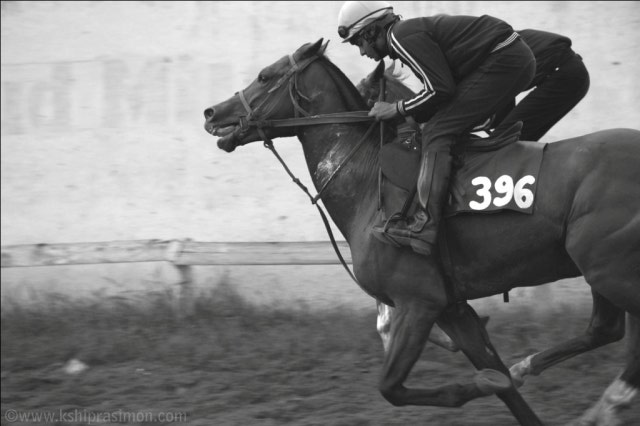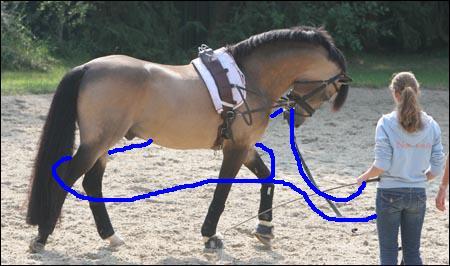QuestionI have a 9mo old filly. I was wondering when I could start teaching her to tie? Also if you have a good method, because she is a fighter. I have had people tell me to start tying her now, and people who told me to wait till she was at least a year. Please help!
AnswerDani,
I recommend teaching young horses this type of thing at a very young age. The last thing you want to do is allow the horse to reach their maximum strength and size potential before you teach them to respect boundaries. This includes leading and tying. So yes, absolutley, its important that you begin teaching your filly to tie now. Waiting could be very dangerous, not only to her, but to anyone else standing in her vacinity.
Since you say she is a fighter, I will walk you through the process I use on hard to tie horses. She is still young enough to learn. The point to this process serves two purposes, one: she will fight herself and two: she will learn that fighting herself is both exhausting and unproductive.
First you need the right equipment. I recommend a heavy cotton lead (not nylon) with a brass snap. I say brass because its a lot hardier than its nickel plated or stainless steel counterpart. Next you will need a good heavy halter (double stitched) with brass fittings. Again, these are more durable than the single layer halters with nickel plated or stainless steel hardware. The final thing you will need is a large inner tube (for a tire). Bicycle inner tubing will be too small, farm tractor size will be too large. If you can find a size between that, you will do well.
The next concern is location. You want your filly in a quiet place where noise and distraction wont cause her undue grief. The idea is to get her to disagree with herself, not get her nerves worked up wondering what everyone else is doing. You want to be sure your space is safe, no dangerous corners or debris that she can cut herself on or step on. Safety for you and the horse is paramount and of the utmost importance!
Secure the inner tubing (preferably tied to a tree or some other sturdy area) with heavy cotton rope or chain. This part will not touch the horse, but it is crucial as it serves as the anchor to your inner tube. Once the inner tube is safely and securely attached to the surface you are using, bring your filly to it. Allow her the oppertunity to get comfortable with the inner tube while you have her in hand. This can be scary to a baby! So let her further her trust in you by standing with her until she has accepted the tubing.
Once she has done this, closely tie the lead rope (I hope you got the cotton one with brass fittings) to the inner tubing. Use a slip knot. Any other knot will get too tight and you wont be able to get your rope undone if you dont. Make sure there is nothing else on her with the exception of the dual layered halter and the lead rope (which should be attached to the underside ring of the halter). Get her as close to the inner tube as you can for several reasons. The most important being, you dont want her to get tangled in the excess, nor do you want her focusing on the reaching for grass. This is instruction time, not eating recreational time. Distinguish the difference.
After you have secured her rope close to the inner tube and have verified that the inner tube is safely hung at a comfortable height (wither heigt or slightly higher) and you are sure that its held adequately, take a step back away from your filly. Now would be a good time to get far enough away from her so that she understands the isolation. Keep her in your sight if you would like, but remember, when she fights, she has to learn that she is fighting herself and learning that its exhausting and unproductive.
When your filly begins to fight the rigging, she may pull, she may rear, she may lunge, she may even bite at the inner tubing, but if you will notice, the tubing is constantly giving to her every move, thus, not allowing enough pressure to build for a succesful pullback resulting in the damaging of hardware. She has no choice but to either fight it or stand still. Either way, she is not going ANYWHERE. That is the lesson you want to teach her.
Start slow, and do it in 15-20 min increments and build up from there. It is safe to tie her for an hour or so, and I recommend it as it builds patience which will benefit you so much more later in the breaking process.
I hope this helps you out and remember, SAFETY first! Keep yourself and your filly safe, and everything else will work itself out! Good luck!

 leaning on right shoulder after race
Question
leaning on right shoul
hello maam, this
leaning on right shoulder after race
Question
leaning on right shoul
hello maam, this
 tongue up
Questiontongue up
QUESTION: hello maam, is this
tongue up
Questiontongue up
QUESTION: hello maam, is this
 K K snaffle
Question
K K snaffle
hello, what are K K snaffles? is i
K K snaffle
Question
K K snaffle
hello, what are K K snaffles? is i
 lungeing a horse with lunge line from chest to hock passing
Question
lungeing a horse with
hello, yesterday i had
lungeing a horse with lunge line from chest to hock passing
Question
lungeing a horse with
hello, yesterday i had
 breaking a yearling
Question
breaking yearling
hello. may i know why cow bo
breaking a yearling
Question
breaking yearling
hello. may i know why cow bo